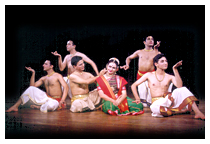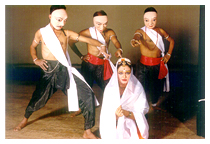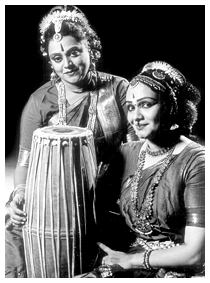Prathibha teaches Bharatanatyam to a select few. She tries to instill in her students the same commitment and zeal that she brings to her dance and dance related activities. Prathibha reveals through her choreography of varnams, keertanas, tillanas and other such items the freshness of approach within tradition, exploring the different facets of the form which has inexhaustible possibilities.
Seeta - Parallel Realities - a solo three act production that centres around Seeta as Svayambhu, the embodiment of the kinetic quality in the telling the story of Rama.
Seeta, one born out of Prakriti, and the one that dissolves into it, is Prakriti itself and Prakriti consists of the three gunas - Sattva, radiance; Rajas, kinetic energy and, Tamas, the state of inertia.This narrative of Seeta includes significant variations that has changed the conceptualisation of character, event and meaning.Prathibha added a fresh and powerful dimension to Seeta. The Seeta of Prakriti is bold, replete with a sense of undiminished conviction that she has done no wrong and would rather seek the solace of her mother earth than subjugating herself to various tests. Prathibha's portrayal of the pregnant Seeta spelt pathos and courage.
Call of the Flute - an innovative production that combines Bharatanatyam and Kalaripayattu deals with the strength, purity, honesty, self sufficiency, joy and laughter of rural India immediately after independence and thereafter neglect of the villages and the directionless, dishonest, confused chaotic intense urbanisation. The imagery is traditional - Krishna symbolising the Indian nation builder, Radha symbolising the deserted village and, the Flute - a symbol of harmony or integrated development. Many shows were held at conferences and festivals.
She has given contemporary interpretations of traditional texts, Call of the Flute is an interpretation of Krishna as a post-independence Indian statesman who gives up Radha, the village class, signifying village India. With the idealist in him dead, Krishna cannot play the flute, a metaphor for harmony.
Rhythm and Harmony - a combined choreography of Bharatanatyam, Kathak, Mohiniattam and Odissi is based on Kalidasa's Ritu Samhar. This special choreography explores the dialectics of four different styles of classical dances coming together. It was premiered in Hannover, Germany on 15th August, 2000 for the Indian National Day celebrations and at various venues for the next ten day thereafter. Performed for the APPAN (Asia Pacific Performing Arts Network) conference in New Delhi in October 2000; at Sharad Vaibhava Festival in Bangalore in December 2000; Asia Pacific Tourism Meet in Delhi, 2001; Sri Krishna Gana Sabha, 2001 and Pune Ganesha Festival 2001.
Ritu Samhar - an interesting presentation of four styles in conjunction - Bharatanatyam, Mohiniattam, Kathak and Odissi, with well-known dancers - Prathibha Prahlad, Bharati Shivaji, Shovana Narayan and Ranjana Gauhar - as the performers. The mellifluous music set the tone for a serene and intellectually satisfying experience.
"RHYTHM & HARMONY" Production Concept - Prathibha Prahlad 
"CALL OF THE FLUTE" Choreography - Prathibha Prahlad
"KRISHNA'S WIDOWS" Production
"SHABDA RUPA" Production Swapna Sundari & Prathibha Prahalad
Shabda Rupa - a special dance presentation in a duet format, with Kuchipudi dancer Swapnasundari and a 15 member percussion ensemble, was presented at Sharad Vaibhava Festival in December 2000 in Bangalore.
Shabda Rupa - a powerful presentation by renowned dancers Prathibha Prahlad and Swapnasundari, who performed with a 15-member percussion. Prathibha Prahlad and Swapna danced inspiredly and with great involvement. With swara improvisations that flowed like a river in spate, the experience was exhilarating.
The Beat of the Drum - Shabda Rupa, a powerful presentation by renowned dancers Prathibha Prahlad (Bharatanatyam) and Swapnasundari (Kuchipudi). The emphasis was on the rhythmic aspect of the dance, of course.
Sringara, Shuchi, Ujjwala - a celebration of love - is a multi-media dance-theatre production. Selecting songs from poets in seven different languages, she has strung them carefully so as to blend the poetry of one region and language harmoniously into another. Prathibha Prahlad, newest creation Sringara, Shuchi, Ujjwala has a spectacular sweep, romantic grandeur, musical fervour and narrative richness. The starkness of Prathibha's choreography was as sophisticated as it was infinitely compelling. Indeed Sringara...has all the virtues that make for a total theatre and is worth going miles to see.
Seek God through Dance and Music, is a repertoire of songs for classical dance on the compact disc. This repertoire has specially composed music in the traditional Bharatanatyam format, with nattuvangam, pre-choreographed. The CD was released at the Bharatiya Vidya Bhavan in Bangalore in June 2000.
Poetry in Motion - in aid of Kargil war martyrs. Classical dance to poetry in Sanskrit, Kannada, Tamil, Telugu, Marathi and English was the high point of this choreography.